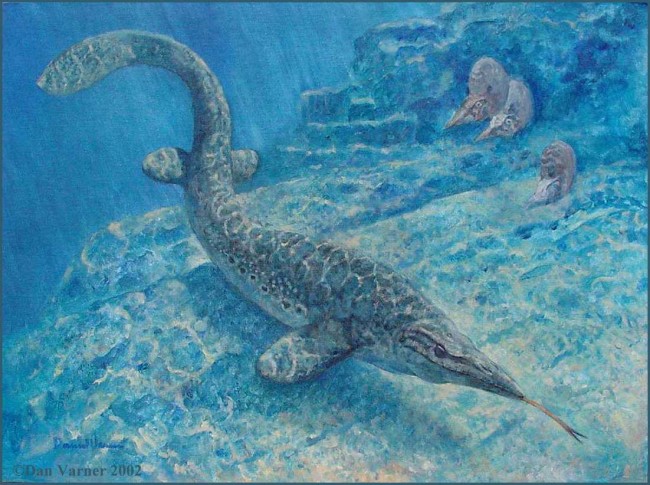Fossils for the Future: What Can Mosasaur Evolution Tell Us About Climate Change
December 17, 2015

Graduate student Joshua Lively made headlines in September for naming and describing an extinct species of prehistoric turtle with a distinctive pig-like snout—work he conducted while earning his master’s at the University of Utah. Now a Ph.D. student at the Jackson School, he’s turned his focus to studying another prehistoric reptile, this one with a bit more bite.
Lively studies mosasaurs, sea monsters of the Cretaceous.
They had scales, a serpentine body and evolved from the same land-dwelling ancestor as modern monitor lizards. They looked a lot like giant aquatic versions of them, Lively says.
“Picture a komodo dragon with flippers,” he adds. Through time, however, different lineages of mosasaurs converged more on the general body plan of other aquatic vertebrates such as fish and whales.

Lively is in the process of examining hundreds of mosasaur specimens kept in collections across the United States. He’s cataloging 240 distinct anatomical features—everything from the shape of teeth to the number of tail bones—to understand the breadth of anatomical diversity in different mosasaur species over the tens of millions of years the reptiles swam the planet’s seas.
While his work is rooted in anatomy and taxonomy, Lively says he’s chasing a larger question by sifting through the ancient bones: How did climate change during the Late Cretaceous affect how mosasaurs evolved?
“Throughout that entire time range, compared to today, the climate is really warm. This is one of the warmest periods in Earth’s history,” Lively said. “We’re interested in seeing if we get similar evolutionary patterns in this prolonged period of warm climate versus what we get in the more recent geologic past.”
Anatomy and taxonomy have a reputation for subjectivity; descriptions often depend on the eye of the beholder. But Lively is approaching his work in a more quantitative way, focusing on measurable aspects of anatomy or the presence or absence of certain features. With the data he can create a numerical value that quantifies the amount of anatomical diversity, or disparity, found across mosasaurs in a period of time.
Lively is still collecting data for his Ph.D. work. But he has a working hypothesis for what he expects to find.
The Late Cretaceous was one of the warmest periods in Earth’s history. But within this period, there were periods of cooler temperatures. Lively hypothesizes that during these cooler periods, the diversity of form in mosasaurs increased; the reptiles specialized and stake out different ecological niches. During warmer intervals, disparity may have been lower because more equable oceanographic conditions may have allowed species to range over larger geographic areas, favoring more ‘generalists’. Lively is also testing several alternative hypotheses.

“Mosasaur evolution is completely restricted to the Late Cretaceous. Their origin, entire evolution and extinction all occur within the Cretaceous,” Lively says. “That’s why I think they’re a good case study for looking at evolution within a greenhouse climate.”
Any trends he reveals by studying mosasaur bones could help shed light not only on ancient climate-biologic interactions, but those happening in the warming world of today. Evolution generally works on such large and gradual time scales that turning to the past is one of the best ways to learn what could be in store for the future, Lively says.
“An important feature of the fossil record is that it holds a deep time perspective of evolution,” Lively says. “The modern time slice is not enough. Paleontology, and geosciences in general, should be seen as our key to the future.”
On Dec. 18, 2015 the Jackson School is showcasing on Facebook and Twitter a sample of mosasaur specimens that Lively is researching. Check the school’s social media accounts to see the posts, or check back here in 2016 to see the archived photos.
For more information contact: Anton Caputo, UT Jackson School of Geosciences communications director, 512-232-9623; or Monica Kortsha, UT Jackson School of Geosciences public affairs officer, 512-471-2241.
